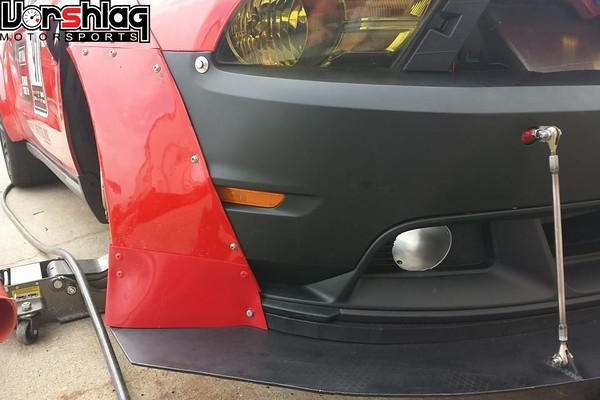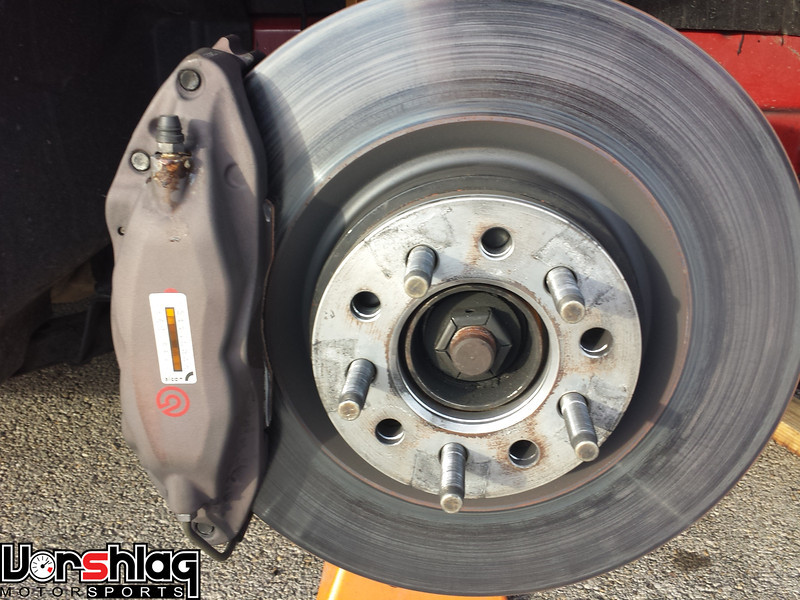...you'd see that they have MORE than adequate fab skills to graft 4" ducting into the front fascia, and in fact have been doing that on various projects (Brianne Corn's PPIR car for example) for quite a while. They can do more than just take a part out of a box and bolt it in place.
Agreed, and thank you for pointing this out, Dave.
Our crew easily converted the front fascia to accept true 4" ducts made of tubular aluminum. They are significantly larger than the 3" opening (3" dia duct = 7.06" sq inches, 4" dia duct = 12.56 sq inches, or 43% larger surface area at the opening).
This means - more airflow. We ran out of time and did NOT open up the backing plate to 4" (we have to start over from scratch and make an all new unit - we we will soon, and offer for sale soon after. The Ford Racing carbon fiber 4" backing plates are mega $$), but with the entire length of hose from the front openings to the backing plate at 4" diameter, it did have more total air flow.
How do I know? Testing. We just got back from a test day last Saturday at a local brake intensive track (ECR). Amy drove the car hard all day, and only managed to see 430°F max indicated temps on the front calipers.
We were seeing 490°F before on the fronts, so that's about a 60°F drop. She was hot lapping the car all day and went through tanks of fuel on a warm-ish 85°F day, at a track we have a LOT of testing at. So instead of arguing "dimples" improving aero based on a freakin MYTH BUSTERS tv show, we're out testing the changes we are making, to see if they really work.
Next up - we will re-fabricate the backing plates to work with 4" hoses and remove the restriction. We will also try to replace some of the flexible, corrugated hose with aluminum or plating tubing (we ran out of time to do that) with a less tortured path than what the 4" hoses have now (see above).

Rear brakes: Once people find the "TCS OFF" button on track, rear brakes stop being a problem. They don't get hot enough to worry about, and even with the stock 12" rears, there is enough brake torque to balance the fronts in 13" or 14". If the rear brakes were such an issue, don't you think the $100,000+ Boss302/R would have something more back there? It doesn't, and competes successfully right out of the box. From a pure performance standpoint, the 14" rear conversion kit is there for one reason, and one reason only: to fill those ridiculously huge 19" wheels with brake rotor. In the end, it's an appearance mod, so that you don't have an acre of empty wheel barrel in back, with this tiny little peanut brake setup.
Well... yes and no. Yes, turning off the TCS is the biggest improvement to rear brakes anyone could make. But we never ran with that on. We
did see some
somewhat high temps on the 11.5" rear brakes, and rotor and pad wear were very accelerated. We didn't try ducting, which may have worked well, but there wasn't a good way to package this on a street-ish car, and ultimately that is our goal - to find solutions that we can sell to other folks, instead of building a one-off race team solution.
Again, our car is a bit atypical with respect to weight (3802 with driver and ballast in TT3 trim), aero loading, grip levels (345mm Hoosier A6) and overall speeds (lately our TT3 laps have been 7-10 seconds/lap faster than American Iron records).
With the upgrade we made to the 13.8" GT500 rear rotor over a year ago we are seeing much longer rear rotor life, at least. Rear pads still wear faster than I want, but better than they did before. We ran almost 8 months on a pair of GT500 rear rotors, and are only on our second pair in 12 months of use.
But yes, a lot of people do this "14 inch rear brake upgrade" for the looks. It happens. Especially in the 19" OEM wheels... the 14's fill it up.
Looking at 4-piston rears with a solid axle, that's again for bragging rights. If it's a radial-mounted fixed caliper, you'll have knock-back for DAYS as the axle play lets the rotor slide in and out. The only way that will work is with some kludged-together floating caliper mount, and again, you're adding mass to no purpose.
Agreed, this type of fixed caliper rear brake never works on a solid axle car like the Mustang.
Seriously, guy, you only half-understand a lot of the concepts that you're pontificating about, frequently promulgate blatantly WRONG information, and make pretty ludicrous or bloody obvious suggestions on a fairly regular basis. Terry's advice is spot-on: Read more, post less (tm). And, in particular, post only when you have something SOLID, CORRECT, PROVABLE, and DEFENSIBLE to offer. Of course, questions are fair game.
Agreed. Unfortunately Penatalab has added literally nothing to this thread or sub-forum of worth. He is just regurgitating crap he has read elsewhere... and we don't need that on S197forums. Most of us have been to those other Mustang forums, the ones where the "group think" is mindless and broken, and bad tech is spewed as gospel every day. We simply don't need that kind of "tech help" here.
The GT500 (15") rotor weighs nearly 33#.
Yes indeed. The 15" 6-piston rotor is an absolute boat anchor at 33 pounds. We've upgraded/installed these GT500 front brakes for some S197 customers here (when they wanted bling more than performance, against our recommendations) and I was amazed at the weight. The 6-pot caliper isn't that much heavier, though.
The 14" front for the Brembo cars is heavy enough (just a tick heavier than the massive 18x12" wheels we use), but the 15" rotor is just plain silly.
The 2-piece 14" rotors from the Boss302 are about 6 pounds lighter than the 1-piece 14" OEM units, and we've looked at going to a 2-piece rotor for our car... but the costs are
heinous. If we were a well funded Pro team we'd do it, of course, but we are not. I suspect none of you here are either. Figure $400-750 each for 2-piece 14" fronts.... vs $99 for good quality 1-piece fronts.
As for the rear brakes, the stock GT rear rotor is about 13 and a half pounds, whereas the 13.8" GT500 rear is a hair over 16 pounds. The extra 2 and a half pounds was worth it to extend rotor life as much as we have.

On the optimaztion of the rear rotor- there are a few things to account for. There was a massive thread over on C-C about this exact question last summer, which devolved into people putting "math equations" up. Anyway- If you're a PWC team, or Roush Racing, or Rehagen or somebody, you can duct the shit out of the rears, and you can change literally everything back there between each race, so...it doesn't really matter that it's a 12" rotor. If you're Terry or a club racer, your budget is not a pro-race team budget, and, in Terry's case, he races what he sells. That red car is a parts test-bed and advertising platform more than anything else- to run a setup on it that is not saleable is not his goal (I'll look past the reverse-ducted hood...). Therefore, the bigger rotor will add some lifespan. That's about all the benefit you'll get- the fronts, in one session will still overheat faster, but there's less of a chance that the rears will overheat first, and will eliminate the need for ducting for track-day poseurs like me.
Well said... that's exactly why we didn't duct the rears. It is much harder to do than up front and the hoses generally hang under the car and get ripped off in any off-track excursion. The heavier and larger diameter 13.8" rotor upgrade was just easier and they last a good bit longer than the stock bits, as we've seen.
edit: I am utterly ignoring the "dimpled aero advantage" bodywork silliness from here on out, which was spawned from urban myth and reinforced by the goofballs on myth-busters. Please take it to another thread. Thanks. 


















